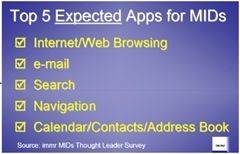In a recent ‘Thought Leaders’ study by Phil Hendrix of IMMR, a number of (US-based, I believe)people were asked the following question:
Three years from now, among individuals who own or use a PC, cellphone or smartphone, at home or work, what percentage do you think will have purchased a MID, again, by Q3 2011.
The average prediction is that by Q3 2011, 33% of these people will have a MID.
I know what you’re thinking. ‘No way.’ That’s what I thought until I read their definition of a MID. The IMMR definition of a MID is:
MIDs, or Mobile Internet Devices, are a new class of devices/PC’s that offer many of the features of a PC, but at 1-3lbs. are lightweight and portable enough to easily carry and use virtually anyplace, at any time.
Its not the definition that Intel use but its certainly the definition I’m hearing from ARM, Ti and others that regard even netbooks as mobile Internet devices. Based on that definition, I totally agree with the ‘Thought Leaders,’ whoever they may be.
 A complimentary copy of the report, titled ‘The M in MIDs stands for Mobile’ and sponsored by GigaOM, the GSMA mobile Innovation Market and InMobile, can be downloaded from the IMMR website at www.immr.org and it’s an interesting read covering more than just the penetration question. There are some quotes from the respondents included too like these two that I hear a lot: “Someone who has an iPhone right now, essentially has a MID already” and “With smartphones taking on 80%+ of MID-type activities, it will be tough to convince people to carry yet another device.” So if the iPhone is a MID and more voice-enabled MIDs are on the horizon, what are we arguing about? Based on this segment of the market alone I’d say we will reach 30% penetration by end of 2011. Add netbooks into the mix and it’s almost a certainty but for me, the even nicer thought is imagining the hundreds of variations of mobile Internet-enabled devices that will appear.
A complimentary copy of the report, titled ‘The M in MIDs stands for Mobile’ and sponsored by GigaOM, the GSMA mobile Innovation Market and InMobile, can be downloaded from the IMMR website at www.immr.org and it’s an interesting read covering more than just the penetration question. There are some quotes from the respondents included too like these two that I hear a lot: “Someone who has an iPhone right now, essentially has a MID already” and “With smartphones taking on 80%+ of MID-type activities, it will be tough to convince people to carry yet another device.” So if the iPhone is a MID and more voice-enabled MIDs are on the horizon, what are we arguing about? Based on this segment of the market alone I’d say we will reach 30% penetration by end of 2011. Add netbooks into the mix and it’s almost a certainty but for me, the even nicer thought is imagining the hundreds of variations of mobile Internet-enabled devices that will appear.
Related article: MID, a definition that is hard to ignore.











So a MID to them is basically a PDA with possibly GPS and definitely Internet thrown in.
That’s a broad definition, but I would question the Mobile part of it. Where is the cut off line. Personally I would stop at 6″ screen, otherwise you have to decide by weight and I would go for 500g as a max weight. If not it becomes a question of “What does Mobile mean?” After all a laptop is mobile!
No, what’s worse, a mid means a UMPC too, since also that falls under the 3LBS category.
A mid would be fine if it was any device with a smaller than 7″ screen/frame (not like the EeePc which essentially is a 7″ screen in a 9″ form factor).
If a mid has these definitions, then ultra portable laptops like expensive business laptops also fall under that category.
One in three rich people :)
Did I read that definition right? “1-3lbs”? That would exclude all the smartphones and MIDs (such as the AIGO P8860, Nokia N810, Argos x, Viliv, UMID MID, …) leaving only todays UMPC’s and lighter end of the netbooks…
All UMPC’s and MIDS have the wrong form factor to generate any real sales. Yes people want a full PC everywhere but they want it functional. That means it needs to follow the laptop format with a touch type keyboard. People are not wanting a thumb input full PC nor a pen only inut full PC, and they want it small enough to fit in a pocket. Until the market realizes that sales of MIDS and UMPC’s will remain weak.
What we need is a rebirth of the old handheld form facotrs like the Psion 5mx. If they provided that type of device that ran windows it would be easy to see those numbers. The reason is most people want just one PC to be mobile but it must be good enough on input to do the same functions as a laptop. Something 7″ x 3.75″ x 1″ roughly would be ideal.